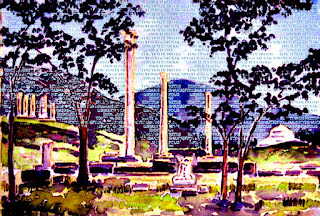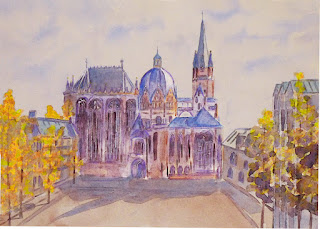Following my last blog post about paintings
of eigth century CE archaeological sites relating to four very different
cultures, I decided to write about paintings of archaeological sites from the
same geographical regions – Americas
& Pacific, Europe, Near East & Africa and Asia – reflecting third century BCE sites.
Once again, Europe was the area for which I didn’t already have a
painting, and I selected the island of Delos in Greece. Despite the title, it and the other paintings posted here do not in fact show 'what the third century BCE looked like' at all. They show what some third century BCE sites look like now – except for the painting of the plank longhouse, which is based on an old photograph and shows what the coastal settlements looked like in the nineteenth century.
Europe
 Located
at the centre of the Cyclades, Delos was an important centre in Greek mythology
and history. The Terrace of the Lions, shown here, originally had as many as
twelve squatting, snarling marble guardian lions when built in the seventh
century BCE. However, following the death of Alexander the Great in the fourth
century, increasing political disarray, the lack of water and trading
infrastructure on Delos caused the island to go into decline. It was for a time the centre of the slave
trade and eventually came under Roman control.
Located
at the centre of the Cyclades, Delos was an important centre in Greek mythology
and history. The Terrace of the Lions, shown here, originally had as many as
twelve squatting, snarling marble guardian lions when built in the seventh
century BCE. However, following the death of Alexander the Great in the fourth
century, increasing political disarray, the lack of water and trading
infrastructure on Delos caused the island to go into decline. It was for a time the centre of the slave
trade and eventually came under Roman control. Americas & Pacific
First Nations of the British Columbia coast and islands of Haida Gwai built the first permanent habitation in that region – plank longhouses – in the late fourth and third centuries BCE.
Near East & Africa
When Alexander the Great died, his empire was divided among three of
his generals. North Africa, the part that went to General Ptolemy fared much
better than the European and eastern Mediterranean sectors. The city of Ptolemais in present day Libya
was founded in the third century BCE by Ptolemy III, a descendant of Gen. Ptolemy.
Much later, after the Romans took over, Diocletian imposed wage and price
controls, which I have superimposed on this computer painting.
Asia
Meanwhile, in the Far East, construction of the Great Wall of China began late in the third century during the last years of the Qin Dynasty. It was expanded, strengthened and maintained by the Emperors of the Han Dynasty (206 BCE - 220 CE).
Meanwhile, in the Far East, construction of the Great Wall of China began late in the third century during the last years of the Qin Dynasty. It was expanded, strengthened and maintained by the Emperors of the Han Dynasty (206 BCE - 220 CE).















